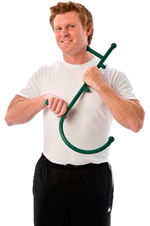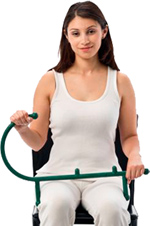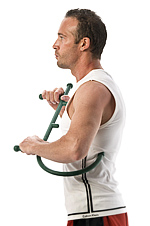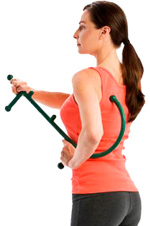Clinical Applications
Self-Management Of Soft Tissue Syndromes
(This article appeared in “Advanced for Directors in Rehabilitation” by Barbara Headley, MS, PT.)
Therapists working in orthopedics and chronic pain programs often face the dilemma of having a patient who has pain, but for whom all the diagnostic tests are negative. Treating soft tissue dysfunction, especially pain in muscle, is all too familiar to us. Treating these, or any other patient in tight managed care environment demands that we emphasis treatment that targets the dysfunction, and self-management skills by the patients. The Thera Cane is one of the best self-management tools I have been able to offer my patients.
THE TREATMENT OF MYOPAIN
The Thera Cane allows the patient to treat virtually all trigger points associated with myofascial pain syndrome (MPS) with less (if any) long-term assistance from health care providers. The problems of MPS seldom resolve never to return. There may be some inherent vulnerability in the muscle tissue that makes the muscle prone to recurrent trigger points. These trigger points cause both pain and muscle dysfunction. The ability of many individuals to work with complex MPS is dependent upon management of these trigger points whenever they flare up. The key to management is intervention immediately when the flare-up begins, not several days later when they can get in to see a therapist. The key is self-management, and the Thera Cane is the ideal tool.
Myopain is a problem for people with fibromyalgia as well. Fibromyalgia patients often have a mixture of both tender points and trigger points. The trigger points may reflect a more localized problem, the fibromyalgia a more generalized one. These individuals find that the Thera Cane may be helpful for both tender points and trigger points, and reduction of myofascial pain related symptoms may assist in maintaining a higher level of function.
The Thera Cane is a curved, fiberglass tool that has several knobs on it. The mechanics of this tool make it very easy to use, with little force needed to apply adequate pressure to the trigger point causing trouble. It feels quite awkward initially, and patients tend to fumble with it. I encourage them first to get the feel of it before they begin seriously to address their trigger points.
One of the most important lessons I learned as a chronic pain patient who has had two fusions is that I need to feel some control over the soft tissue pain that remains after a very successful fusion. If I did not have a tool I could take with me on lecture tours or vacation, I would travel much less and I would be much more dependent upon medication, and other health professionals assistance. Instead, I carry the Thera Cane wherever I go and treat trigger points as they start to become a problem, reducing my discomfort before it really develops. This sense of self-efficacy I pass on to my patients, who always express some degree of being out of control with their pain. When symptom reduction is at one’s fingertips, anxiety and pain are reduced and function increases.
HOW IT WORKS
Pressure on the trigger point deactivates it, although the exact mechanism is not known. Measurements of sensitivity pre and post treatment show a decrease in pain, reports by the patient reveal the referred pain pattern is not present after successful pressure has been applied, and often the patient will demonstrate an immediate change in range of motion. Diligent use of the Thera Cane to perform the pressure techniques, therefore, is critical in early and effective management of the trigger points. While the patient reports that the decrease in referred pain is the desired outcome, as a therapist specializing in sEMG for 10 years, I recognize the reduction of muscle dysfunction as the primary benefit. MPS is a movement disorder, and the trigger points “fuel” the muscle dysfunction that develops. Early intervention reduces the potential of a chronic movement disorder developing, with one or several prime movers no longer functioning.
EDUCATING YOUR PATIENT
Patients often quickly see the Thera Cane as the solution to their chronic back pain problem. Years of working with this tool and patients has taught me that patients need to be cautioned about trying to fix the problem in one day because they finally have the means at hand. I teach patients that using the Thera Cane requires adherence to certain principles to reduce the muscles from tightening up to protect the area. Health care mandates that we not only provide patients with proper tools, but that proper instruction in the tool be included. The Thera Cane Co. has developed a video on the use of the Thera Cane to supplement instruction by the therapist.
Patients who have good self-management skills have much less anxiety about their pain, take medication less, and return for treatments less often. That is not only a benefit to the insurers. The patient is able to function at a higher level and enjoy activity more. The employer sees a reduction in lost time from work. When used at the work site, there are less claims filed and less productivity lost.
WHO IT HELPS
Although the Thera Cane may appear to have the greatest application with soft tissue (muscle pain), the tool has also been helpful to patients with arthritis, stroke and spinal cord injuries. Anyone who moves in a compensatory movement pattern has altered the biochemical stresses on joints and muscle. These muscles are then vulnerable to MPS regardless of the original injury or disease, Elimination of the muscle dysfunction in an arthritis patient may reduce their pain to very manageable levels, even though the underlying disease process has not been changed. In short, the Thera Cane can be used by anyone, anywhere, anytime they want to reduce pain and discomfort. Patients like the independence, payers like the cost reduction and most of all, the patient is put back in control.




